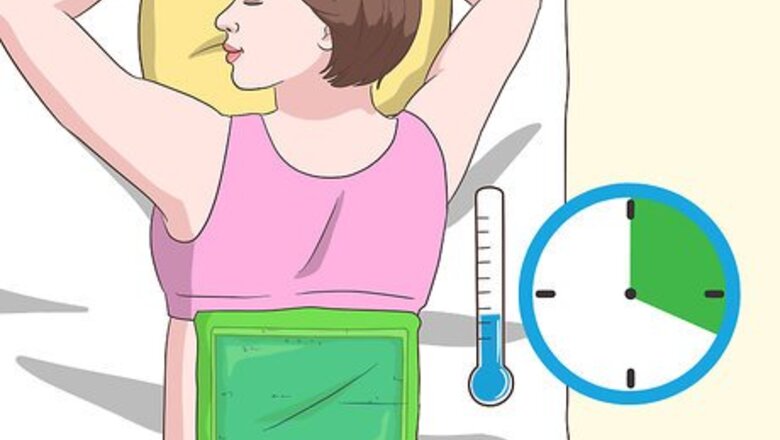
views
Alleviating Your Pain
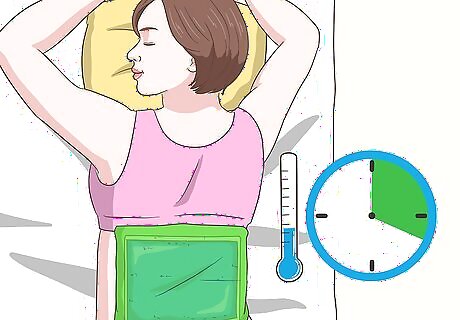
Soothe the pain with cold therapy. Place an ice pack on your lower back for about 20 minutes during the first 2 days you're experiencing pain. Wrap the ice pack in a towel or an old t-shirt so that it doesn't have direct contact with your skin. You can do these 20-minute sessions as often as once every 2 hours. If you don't have an ice pack, you can use a bag of frozen vegetables. Another trick is to soak a sponge in water, put it in a plastic bag, and freeze it. Then wrap that in cloth. You might want to use a second bag to prevent leaks. Using an ice pack for more than 20 minutes can burn your skin or damage your nerves.
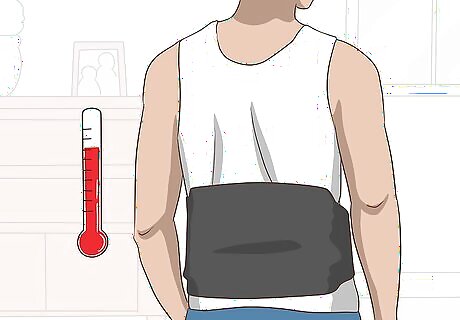
Switch to heat after 2 days. If your lower back pain persists, heat can help improve circulation to the area to stimulate healing. Heat also disrupts the pain messages your nerves send to your brain, so your back will feel better as a result. Try using a heating pad with adjustable settings. This way, you can adjust the temperature as necessary to meet your specific needs. Just remember to avoid falling asleep with the heating pad on. If you don't have a hot water bottle or heating pad, you can soak in a warm bath. Moist heat is better than dry heat because it will prevent your skin from getting too dry and itchy.
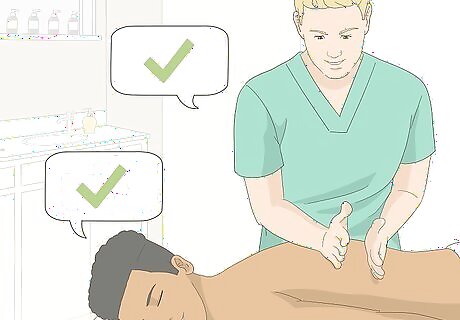
Try massage therapy. Regular massage therapy can improve circulation and relax your muscles, providing some relief for your lower back pain. While you may feel a difference after just one session, multiple sessions are typically needed for more long-lasting effects. There are more structured or targeted therapies that treat your lower back specifically. However, a general, therapeutic massage will have similar effects. Massage also reduces stress and tension, which can improve your lower back pain. You might also try other stress-relieving practices like deep breathing exercises or meditation.
Try to keep moving, if possible. Sitting or laying in bed for days at a time isn't going to help your recovery much. You do want to take it a little easier than normal, but try to do what you can to get up and moving throughout the day. Try to do the things you normally do, but scale them back. For instance, if you normally go for a long walk, you might take a short walk instead. If you're used to going for a bike ride, you can still go, but don't ride as long.
See a physical therapist if the pain is unmanageable. If your back pain lasts for more than a couple of weeks or it's serious enough that you're having trouble moving around, make an appointment to see a medical professional. While you can see your doctor if you'd like, you may be able to get more targeted medical advice by turning to a physical therapist or chiropractor, instead. They can advise you whether any medication is needed to ease your pain.
Improving Strength and Flexibility
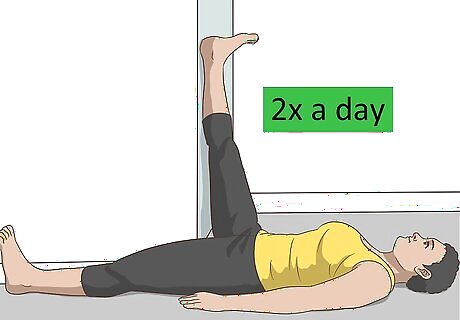
Stretch your hamstrings twice a day. Many people overlook the role hamstrings play in supporting your lower back. If you have lower back pain, tight or shortened hamstrings may be to blame. Lay on your back on the floor, facing a wall or the side of a couch or chair. Raise one leg so that it is extended with the heel resting on the wall or piece of furniture. Stay in this position for 20 to 30 seconds, breathing deeply, then switch to the other leg. You can do a similar stretch with both feet up the wall if you want to stretch both hamstrings at the same time. You may want to place a rolled towel under your lower back for support.
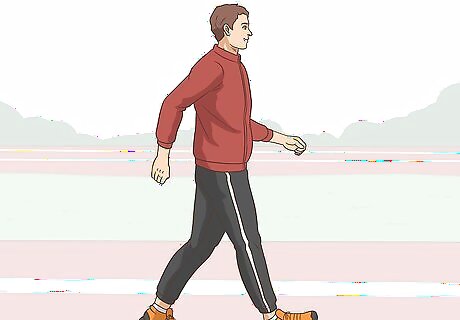
Start a walking regimen. Walking is a low-impact activity that is generally easy on your back. If you're new to fitness and exercise, a walking regimen can be a great way to start moving into an active lifestyle. Being more active can improve your health overall as well as decreasing your lower back pain. Depending on your overall fitness level, you may want to start with brief 10- or 15-minute walks. Gradually increase the time and distance of your walks until you are walking for 35 to 45 minutes a day, 3 to 5 days a week.
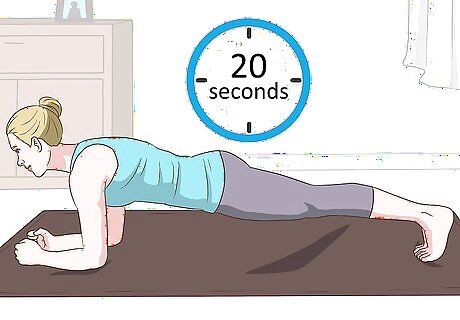
Strengthen your core. Each time you work out, spend some time on exercises that will strengthen your core, like sit-ups, crunches, hip raises, and planks. To do a plank, for instance, start by lying on your stomach propped up on your elbows with your forearms flat on the floor. Engage your abdominal muscles and raise your body flat off the floor until you are supported solely by your forearms and your toes. Hold the position for 20 seconds to a minute, then lower and repeat. Gradually increase the amount of time do these core-strengthening exercises. Your core muscles act as a natural corset to keep your torso erect and your spine straight. The stronger your core is, the less strain you'll put on your back.
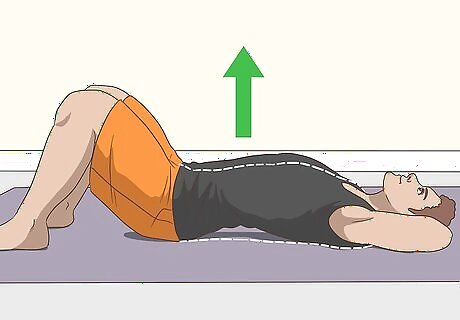
Add exercises that target your lower back and hips. If you strengthen your hips and lower back muscles, they'll be able to handle a lot more without getting overworked and sore. Simple bodyweight exercises can strengthen your lower back and hip muscles without the need for a gym membership or fancy workout equipment. Knee rolls strengthen the core muscles on either side of your spine. Lie on your back with your arms straight out from your shoulders and your feet flat on the floor with knees bent. Slowly roll your knees to one side, keeping your shoulders flat on the floor. Return to center and repeat on the other side. Do 10 repetitions on each side. Strengthen your hips and pelvic floor muscles with a pelvic tilt. These muscles help support your lower back. Lie on your back with your feet flat on the floor, about hip-width apart. Flatten your lower back to the floor and engage your core. Then tilt your pelvis towards your heels until you feel your lower back lift off the floor. Lower and repeat 10 to 15 times, breathing deeply.
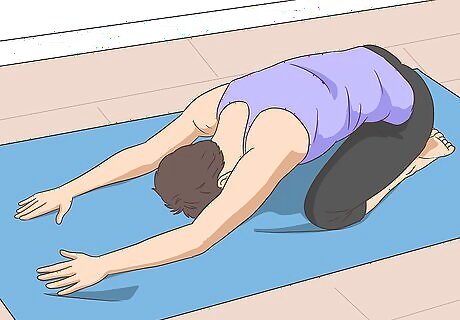
Try child's pose to relax and stretch your back. Kneel on the floor with your big toes touching and your knees about hip-width apart. As you exhale, extend your arms overhead and reach forward to fold your torso over your legs. Lower your forehead all the way to the floor if you can. Then you can pull your arms to rest alongside your torso. If you can't lower that far, you can leave your arms out. You may want to place a block in front of you to rest your head. This pose is a relaxing pose. Don't force yourself into an uncomfortable position. Remain in the pose for 30 seconds to several minutes if you feel comfortable.
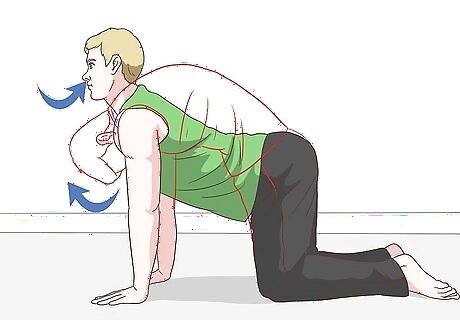
Use cat-cow to improve your spinal flexibility. Start in all fours on the floor with your knees directly below your hips and your wrists directly below your shoulders. Keep your back flat and breathe deeply. On an inhale, press your chest forward and allow your stomach to fall to the floor, arching your back. As you exhale, press your tailbone downward and round your back towards the ceiling. Repeat this exercise 10 to 15 times with a breath for each movement. Try to keep your weight evenly distributed between your knees and your wrists. If the floor is hard on your wrists or knees, you can use a rolled up towel for cushioning and support. EXPERT TIP Eric Christensen, DPT Eric Christensen, DPT Physical Therapist Eric Christensen is a Physical Therapist based in Chandler, Arizona. With over a decade of experience, Eric works in both orthopedic and neurological fields and specializes in custom orthotic prescription and casting, vestibular reprogramming, and manual therapy. He holds a Bachelor’s degree in Exercise Science with a focus in Sports Medicine from Colorado State University and a Doctor of Physical Therapy from Regis University. In practice, Eric takes a developmental approach to rehabilitation utilizing the Selective Functional Movement Assessment. He uses functional movement patterning and manual therapy to return patients to prior levels of function. Eric Christensen, DPT Eric Christensen, DPT Physical Therapist Try a gentle windshield wiper stretch. The windshield wiper move stretches out stiff lower backs. Just lie flat with knees bent and feet together, then let both knees slowly sweep from side to side, like a wiper going across a windshield. It's easy!
Making Lifestyle Changes
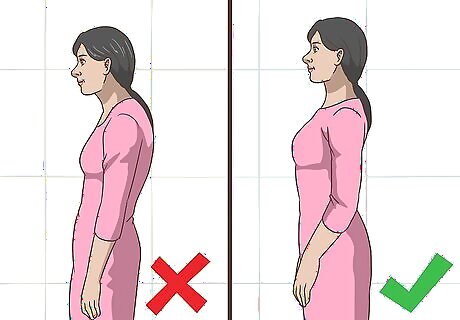
Evaluate your posture. Poor posture may cause or exacerbate lower back pain by placing more pressure on the lumbar region of your spine. Stand sideways in a natural position in front of a mirror and check the position of your back. If you are hunched over, or have a pronounced arch in your spine, you may find relief by adjusting your posture. Hold your pelvis level, not pitched forward or back. Lower your shoulders so that your shoulder blades are tucked in along either side of your spine. Lift the crown of your head toward the ceiling. Sit up straight in a chair and squeeze your shoulder blades together, then relax. Repeat 10 to 15 times. Do this exercise several times a day to help improve your posture.
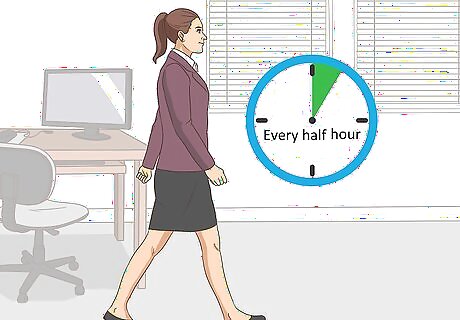
Stand every half hour. If you sit for hours on end at a desk job, that may be contributing to your lower back pain. Every half hour or so, stand up and walk around for about 5 minutes. This simple effort alone can help decrease your lower back pain. If possible, convert your work station so that you can work while standing part of the time. If your boss won't go for that, see if you can upgrade your chair to one that provides more lower back support. Make sure you're sitting straight with your feet flat on the floor, your shoulders back, and your head straight. Slouching or hunching over can put additional stress on your lower back, causing pain.

Adjust your diet. Some foods can alleviate lower back pain, while other foods and drinks can exacerbate it. Potassium-rich foods such as bananas and leafy greens may provide some lower back pain relief. Lower back pain may be caused by constipation. High fiber foods, including fruits and vegetables, can help alleviate constipation and get you back on track. Make sure you're drinking at least 8 ounces of water a day, since dehydration can also play a role in lower back pain. Avoid processed sugar, aspartame, refined grains, caffeinated beverages (particularly sodas), and alcohol.
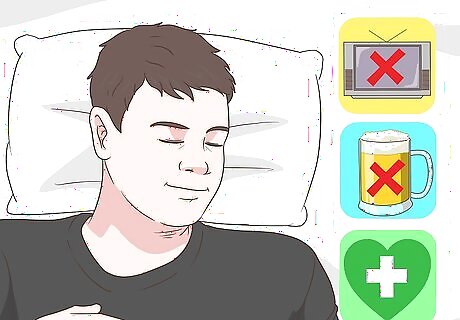
Address any sleep problems you have. Trouble falling asleep or staying asleep often goes hand-in-hand with chronic lower back pain. Often a few simple tweaks to your nighttime habits can improve your sleep quality. Turn off electronics a couple of hours before bed, and don't watch television in bed before going to sleep. If you can't fall asleep in silence, play relaxing music or run a fan for white noise in the background. Avoid caffeine, alcohol, and spicy foods several hours before bedtime. These substances can disrupt your sleep patterns. If you find you can't go to sleep after 20 or 30 minutes, get up and do something and then try again, rather than laying in bed tossing and turning. If simple changes don't do anything to change your sleep patterns, see a doctor who specializes in treating sleep disorders. There are non-habit-forming prescription sleep medications that may help you. If you're having trouble sleeping with lower back pain and you're usually a side sleeper, try placing a pillow between your knees while you sleep. This will help take stress off of your lower back.
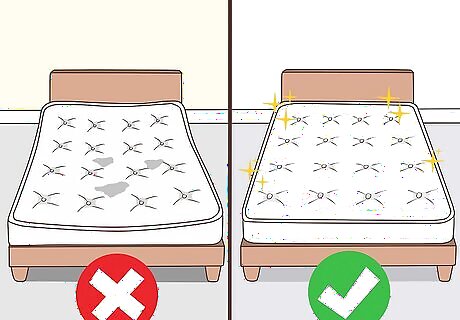
Get a new mattress. If you find your lower back frequently hurts when you first wake up in the morning, your mattress may be the culprit. If your mattress is sagging, or if it's more than 7 years old, it might be time to look for a replacement. If a new mattress won't fit in your budget, consider investing in a mattress pad or topper. These may help make your bed more comfortable by adding extra padding to the top. You may also be able to remedy the effects of a poor mattress by sleeping in a different position. Try sleeping on your side with a pillow between your knees to keep your spine in alignment.

Stop smoking. Smoking decreases the oxygen reaching your tissues, which can cause stiffness and pain. Smokers also have a higher incidence spinal problems such as spinal stenosis, a painful condition where the spinal canal is not large enough for the spinal cord. If you are a smoker and want to quit, talk to your doctor and make a plan. Seeking support from family and friends will increase your chances of success. In the U.S., you can also call the national quit line at 1-800-QUIT-NOW.
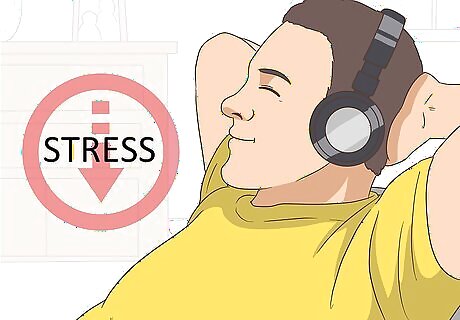
Take steps to decrease stress. Stress can increase tension in your back, leading to lower back pain. While you may not be able to do anything about the aspects of your life that cause stress, you can develop better ways of handling stress. Consider adding low impact exercise to your daily routine, listening to relaxing music, or simply getting out in nature. Mindfulness meditation and journaling can help people deal with issues in their lives. You might also take up a relaxing hobby, such as coloring, crochet, or needlepoint.




















Comments
0 comment